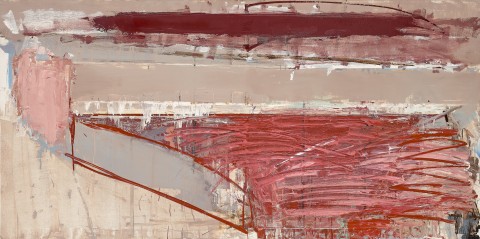RED REFLECTION, 1979
JOHN FIRTH-SMITH
oil on canvas
91.0 x 182.5 cm
signed, dated and inscribed with title on stretcher bar verso: “RED REFLECTION” / Firth–Smith 79
bears artist’s stamp on stretcher bar verso
Gallery A, Sydney (label attached verso)
Tolarno Galleries, Melbourne
The National Australia Bank Art Collection, acquired from the above in October 1979 (label attached verso)
John Firth–Smith, Gallery A, Sydney, 16 June - 7 July 1979
Structures, Newcastle Region Art Gallery, New South Wales, March 1982
The Seventies: Australian Paintings and Tapestries from the Collection of National Australia Bank, National Gallery of Victoria, Melbourne, 15 October – 28 November 1982
The Seventies: Australian Paintings and Tapestries from the Collection of National Australia Bank, Geelong Art Gallery, Victoria, 30 April - 29 May 1988
'The Seventies' Exhibition: Selected Paintings from the National Australia Bank Collection 'Modern Art of the Seventies', Caulfield Arts Complex, Melbourne, 18 January - 11 February 1990, cat. 8
Lindsay, R., The Seventies: Australian Paintings and Tapestries from the Collection of National Australia Bank, The National Bank of Australasia, Melbourne, 1982, pl. 38, p. 51 (illus.)
When John Firth-Smith first secured a substantive profile from the late sixties, he was not only one amongst a new generation of Australian abstractionists, but he also witnessed the spirited arguments about what contemporary Australia abstraction might look like. His career reminds us that the finest painterly abstraction was never a stylistic fling with New York, and indeed Firth-Smith’s nuanced opus remains essential to five decades of Australian painting.
Before the energetic exuberance of Red Reflection, 1979, Firth-Smith’s paintings were large, spacious and saturated in colour. His intuitive sense in developing a painting meant he remained removed from his Sydney Colour-Form contemporaries. The somewhat doctrinaire group at Sydney’s Central Street Galleries held faith in hard-edge formalism and hoped it would find them international acceptance. They enjoyed strident advocacy from Terry Smith, then an emerging Sydney critic and political-cultural activist.1 Firth-Smith wasn’t included in the National Gallery of Victoria’s The Field exhibition of 1968.
After time in New York, in 1971 he returned to Sydney and his first diagonal paintings began. These vast horizontal canvases not only exuded a confidence and certainty which was hugely admired, but also resolved matters dealing with the architecture of the paintings themselves, space and the context of his work within contained physical space.2 They are moreover instructive in revealing a working foundation for the paintings that followed – how they evolved and expanded to become more luxurious, lineal and materially viscous.
Firth-Smith’s thoughtfulness about making paintings and his anxiousness in the studio is never isolated from his circumstances which actually underpin the works’ referential character. His deep affection for the ocean – from openness to harbours – and vessels is critical to him as a person. ‘Densities and atmosphere… if a ship comes into the harbour – and where I’m living now the bridge is amazing because it just hangs there. But a ship comes under that and it almost fills up the space under the bridge… the solidity and the strength of the bridge… incredible manmade ship and it’s all on this soft… water… all those rigs on yachts and ships… have been quite intriguing. It’s all to do with the tension and things supporting things, holding things up, wires…’3
While the end of the seventies might have produced some thinking about recent abstraction itself – what had just happened, where to from here? – Firth-Smith’s path had consolidated. In Red Reflection we see an idea which grew from the mid-seventies – vessels above and below the waterline – where tankers, container ships and their oxidised and rusted surfaces become the synthesis of knowing observation and the adeptness to make an astonishing painting.
1. Central Street Gallery, Sydney (1966 – 1970) was a converted city building and included Tony McGillick, Dick Watkins, Gunter Christmann and others; for a fuller account, including Clement Greenberg’s reaction to their work, see Green, C., ‘Notes on the Centre: Two Decades of American Painting in Australia, 1967’,Tate Papers, no. 32, Autumn 2019
2. Untitled, 1972, synthetic polymer paint on canvas, collection of the Art Gallery of New South Wales, Sydney, Gift of Rosemary Foot, 1972
3. Artist’s interview with James Gleeson, 29 August 1979, Oral History Collection, National Gallery of Australia
DOUG HALL AM
